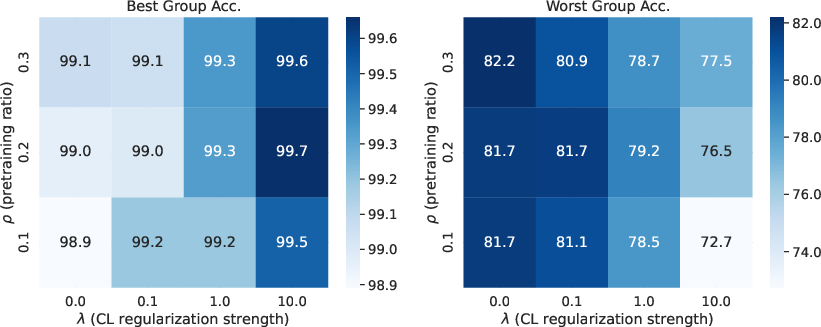- The paper introduces BM-CL, a two-stage framework that reconceptualizes bias mitigation as a continual learning problem to preserve advantaged group performance while boosting disadvantaged group accuracy.
- It integrates established continual learning regularizers like Learning without Forgetting and Elastic Weight Consolidation to combat catastrophic forgetting during bias mitigation.
- Empirical results on datasets such as Waterbirds, CelebA, and CheXpert demonstrate BM-CL’s effectiveness in reducing group disparities with minimal best-group degradation.
Introduction
The persistent challenge of group-level disparities in machine learning models, particularly the "leveling-down effect" where improvements for disadvantaged groups come at the expense of advantaged groups, has motivated the development of new fairness interventions. The BM-CL (Bias Mitigation through Continual Learning) framework reconceptualizes bias mitigation as a continual learning (CL) problem, leveraging established CL techniques—Learning without Forgetting (LwF) and Elastic Weight Consolidation (EWC)—to address catastrophic forgetting of advantaged group performance during fairness optimization. This essay provides a technical analysis of BM-CL, its implementation, empirical results, and implications for future research in fair machine learning.
BM-CL Framework: Continual Learning for Fairness
BM-CL is structured as a two-stage training process:
- Stage 1: Baseline Training via ERM The model is trained using empirical risk minimization (ERM) on the full dataset. After this phase, group-wise accuracies are computed, and groups are partitioned into best-performing (Gbest) and worst-performing (Gworst) subsets based on a balanced accuracy threshold.
- Stage 2: Fine-tuning with Bias Mitigation and CL Regularization The model is fine-tuned using a bias mitigation method (e.g., GroupDRO, ReSample), with an added CL regularizer to preserve performance on Gbest. The overall loss is:
LBM-CL(θ)=LBM(θ)+λLCL(θ)
where LBM is the bias mitigation loss, LCL is the CL regularization term, and λ controls the regularization strength.

Figure 1: Overview of the BM-CL framework, illustrating the two-stage process: initial ERM training and subsequent fine-tuning with bias mitigation and continual learning regularization.
Continual Learning Regularizers
- Learning without Forgetting (LwF):
Implements knowledge distillation by minimizing the KL divergence between the current and previous model outputs for samples in Gbest, thus preserving their predictive distributions.
- Elastic Weight Consolidation (EWC):
Penalizes changes to parameters critical for Gbest by weighting the squared difference between current and previous parameters with the Fisher information matrix.
This modular approach allows BM-CL to be combined with any bias mitigation method and any CL regularizer, making it extensible to a wide range of fairness interventions.
Experimental Protocol
Datasets
BM-CL was evaluated on three datasets with distinct bias characteristics:
- Waterbirds: Simulates spurious correlations between bird type and background.
- CelebA: Contains spurious correlations between hair color and gender.
- CheXpert: Medical imaging dataset with demographic imbalance (age groups).
All experiments used a ResNet-50 backbone, with hyperparameters tuned for each dataset. Performance was assessed using global accuracy, balanced accuracy, best- and worst-group accuracies, and disparity metrics.
Empirical Results
BM-CL consistently achieved the lowest leveling-down effect—i.e., minimal degradation in best-group accuracy—while delivering competitive or superior improvements in worst-group accuracy compared to state-of-the-art bias mitigation methods.

Figure 2: Scatter plot comparing best- and worst-group accuracies across datasets and methods. BM-CL variants (orange) cluster in the upper-right, indicating strong performance for both groups.
Waterbirds
- ERM: High best-group accuracy (99.5%) but low worst-group accuracy (72.8%).
- GroupDRO/ReSample: Improved worst-group accuracy (up to 85.5%) but with notable best-group degradation.
- BM-CL (LwF/EWC): Maintained best-group accuracy (99.0–99.3%) with improved worst-group accuracy (up to 81.6%), minimizing the leveling-down effect.
CelebA
- ERM: Large disparity (best: 99.3%, worst: 46.1%).
- BM-CL (ReSample-EWC): Achieved 93.6% best-group and 82.2% worst-group accuracy, outperforming ReSample alone in both metrics.
CheXpert
- ERM: Substantial group disparity (best: 84.1%, worst: 67.1%).
- BM-CL (GroupDRO-LwF): Achieved 83.6% best-group and 73.0% worst-group accuracy, with the smallest best-group degradation among all methods.
Training Dynamics
BM-CL's two-stage process was visualized on Waterbirds, showing that after initial ERM training, fine-tuning with BM-CL improved worst-group accuracy without significant loss for the best group.

Figure 3: Validation accuracy during BM-CL training on Waterbirds. Stage 1 (ERM) rapidly fits advantaged groups; Stage 2 (BM-CL) improves disadvantaged groups while preserving advantaged group performance.
Hyperparameter Sensitivity
An ablation paper on the pretraining ratio (ρ) and CL regularization strength (λ) revealed:
Implementation Considerations
LwF is more efficient than EWC, as it only requires storing previous outputs rather than computing the Fisher information matrix.
BM-CL can be integrated with any bias mitigation method and CL regularizer, facilitating adaptation to new domains or fairness definitions.
The two-stage process is compatible with large-scale datasets and deep architectures, as demonstrated with ResNet-50 on ImageNet-scale data.
Theoretical and Practical Implications
BM-CL reframes fairness interventions as a stability-plasticity trade-off, analogous to continual learning. This perspective enables the application of a broad range of CL techniques to fairness problems, potentially leading to more robust and equitable models. The empirical results support the claim that positive-sum fairness—improving disadvantaged groups without sacrificing advantaged groups—is achievable with this approach.
Notably, BM-CL challenges the prevailing assumption that fairness necessarily entails a trade-off with overall or advantaged group performance. The framework's extensibility suggests future research directions, including:
- Exploring alternative CL regularizers (e.g., memory-based, parameter isolation).
- Extending to multi-class, multi-label, or regression settings.
- Integrating with causal inference frameworks for bias mitigation.
Conclusion
BM-CL provides a principled, modular approach to bias mitigation by leveraging continual learning to address catastrophic forgetting of advantaged group performance. Empirical evidence demonstrates that BM-CL achieves strong worst-group improvements while minimizing the leveling-down effect, outperforming conventional bias mitigation methods. This work establishes a foundation for future research at the intersection of fairness and continual learning, with significant implications for the development of equitable and reliable machine learning systems.



